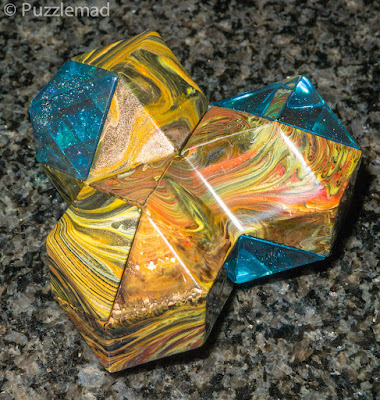
|
|
Do you recognise those shapes? Peanut puzzle by Stewart Coffin |
One of the features of this version that particularly excited me was that
Lewis had recreated a booklet of construction problems to go with the puzzle.
I had had no idea that there was any other challenge other than to use the 6
pieces to make the ring but apparently there are at least 31 achievable
challenges. I say achievable with no real hope of this being achievable by me
as I am absolutely hopeless at assembly puzzles. Stewart's original
instruction sheet said:
From Stewart's original instruction sheet:
"The Peanut Puzzle is based on a two-piece dissection of the rhombic dodecahedron. The half pieces are joined different ways to make this set of six Peanut Puzzle pieces. There are twelve ways that the half-pieces might have been joined in pairs to make usable pieces having no axis of symmetry. This special set of six was found by Mike Beeler, using a computer, to be the only one of 924 possible sets that will construct all the symmetrical shapes below.If any closed loop is considered a Peanut Puzzle construction of sorts, then many others are possible, some having symmetries and some not. See how many you can discover; then sketch them and invent names for them."
Also from Puzzle Craft 1992:
"The object of this puzzle is to join the pieces together in a closed loop to construct all sorts of different geometrical figures, such as those shown below, using three, four, five, or all six pieces. Or you can invent your own. The pieces are fun to just play with. In order to fit together all different ways, the pieces must be very accurately made, so this is not a project for the beginner."
The quality of the casting of the pieces and their sheer beauty is
breathtaking and it even makes me forget about gorgeous wood for once. The
booklet shares the same attention to detail. Beautifully printed and spiral
bound with instructions on what shape to try for and how many pieces to use.
For example puzzle one is as follows:

|
| Excuse the poor photography |

|
| Yay! Solved one! |
|
|
|
|
I was seriously intimidated! I had a little try at the 4th challenge of a Diamond shape and after another whole day, had completely failed to manage an assembly even remotely close! It is great fun trying but after a while I had to put it down. Then I decided to be a complete sucker for punishment and attempt the hexagonal ring which is the shape most commonly associated with it. The picture to the left is from John Rauch's Puzzleworld site.
And of course, you guessed it! I have completely failed to assemble this
shape. Is it just me? Or are these seriously seriously difficult puzzle
challenges. I am fairly certain it is me!
I then wondered whether the puzzle could be modelled in Burrtools and maybe I
could create a full set of the assemblies in BT format. Do I consider this a
"cop out"? Only a little bit. It is all about having fun and I have said many
many times on the site that the making of a BT file for a puzzle is a crucial
part of the fun for me. I have no real experience of using the non-rectilinear
grids with BT so this would be a good chance to try it out. And here is where
I hit a brick wall for a while. When starting a new design the options are:
- Brick
- Triangular prism
- Spheres
- Rhombic tetrahedra
- Tetrahedra-octahedra
I had no clue! I started with the obvious Rhombic tetrahedra grid and could
not manage the creation of any useful shapes. I cannot recall which grid O
settled on but I think it might have been the triangular grid which allowed
me to model the 6 pieces (with huge difficulty).

|

|
Two of the pieces successfully modelled in Burrtools
Time to model the challenges then - this is a whole lot harder! In fact so hard that I cannot do it. I think I will need to ask an expert for advice on how to go about it. The difficulty I am finding is that the shapes in the 2D representation of the grid change with each layer as you go up the z-axis.
If anyone is able to help with this then please let me know. It would be a fantastic resource for the puzzling world to have a BT file with all the challenges in it. Please use my contact page.
This is a fantastic puzzle design by the Master, Stewart Coffin and has been fabulously recreated by Lewis. They are quite time consuming to make but I am sure that he will be making more if you want to buy one from him.





look at this: https://hlavolam.top/interlocking-puzzles-c-7/peanut-p-315
ReplyDeleteInteresting! They look nicely made. It’s hard to beat the version from Lewis but for this cost it’s a really good alternative.
Delete